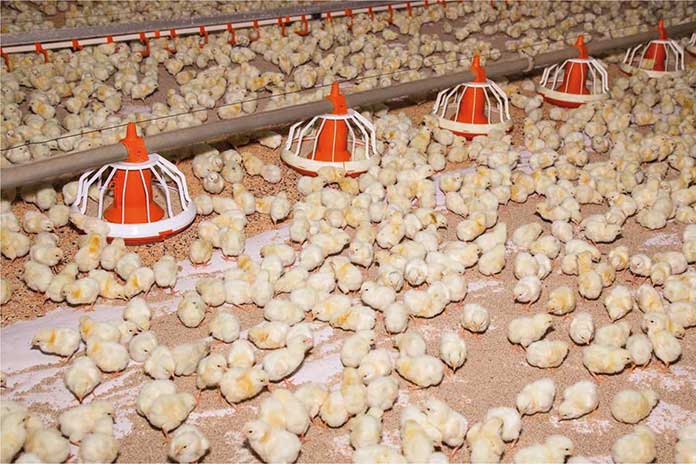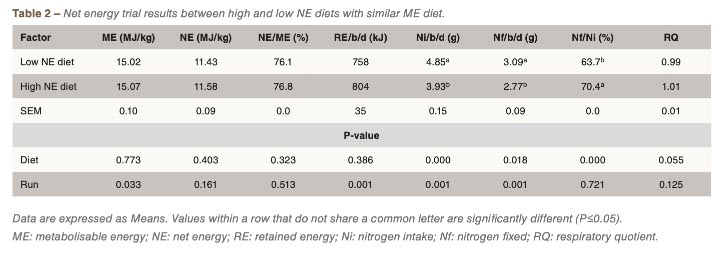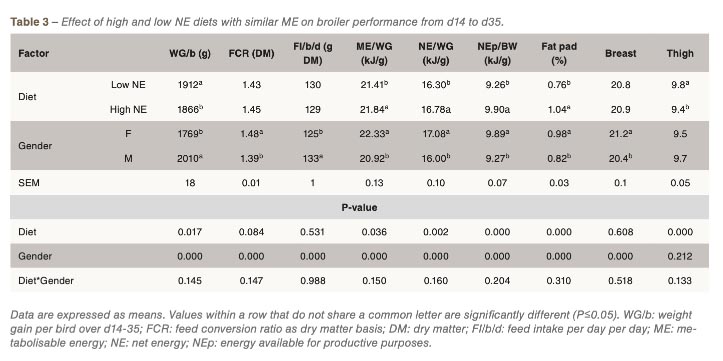
A semi-commercial scale feeding study was conducted to compare formulations of broiler diets based on predicted net energy (NE) and metabolisable energy (ME). It was hypothesised that formulating to NE may result in more efficient use of dietary energy, promoting optimal performance response in the birds. Dietary treatments contained higher or lower NE but with similar ME. Chickens fed the higher NE formulated diet had higher NE cost per weight gain (WG) and also higher productive energy (NEp) per body weight (BW) compared with birds fed the low NE diet.
This resulted in a poorer performance in the high NE birds, such as lower WG, higher fat pad weight and decreased thigh meat yields. The results from this experiment did not confirm a beneficial effect of formulating diet based on NE, most likely due to lower protein level in the NE diet coupled with only a small increase in the NE content of the diet.
The most important cost component of broiler feed relates to energy, as this may account for up to 75% of feed costs. Therefore, more accurate evaluation of feed energy in broiler production is imperative for environmental and financial reasons. The metabolisable energy (ME) system is currently the preferred measure for determining energy utilisation in poultry feed. However, this system does not give a complete picture of the amount of total energy actually available to the bird for maintenance, growth or production. It has been postulated that broiler feed formulation based on net energy (NE) may be more accurate and cost-effective than the current ME system, as has been shown in ruminants and pigs. However, this system has yet to be successfully assessed in poultry and is thus not yet ready for use in commercial poultry diet formulation. Researchers at UNE have developed the equations for predicting NE in diets using closed-circuit chambers, and these equations have been validated in a range of diets. A controlled large-scale experiment is, however, required to validate and confirm whether NE formulation is advantageous over ME based formulation. The aim of this study was to evaluate whether a high NE diet is advantageous compared to a low NE diet with similar ME, based on bird performance and meat yield.

Two experiments were undertaken with commercial feather sexed Ross 308 chicks. Experiment 1 involved a NE study in sealed respiratory chambers, whereas experiment 2 involved a semi-commercial floor pen feeding study. In experiment 1, a total of 40 day-old chicks obtained from two different batches was randomly assigned into 2 runs of 10 closed-circuit respiratory chambers per run, with two birds per chamber (one male and one female). This ensured there were 10 replications per dietary treatment, with 2 birds per replicates. The two dietary treatments, based on wheat, corn and soybean meal, were formulated to contain similar ME values with one higher and another lower in NE, where crude protein (CP) and ether extract (EE) varied according to their contributions to NE as reported in Wu et al., (2018). Amino acid spectrum used was obtained using AminoChic 2.0 software. The high NE diet contained 19% CP and 7.5% EE. The low NE diet was formulated to contain 24% CP and 6.4% EE. A common starter diet was fed to all birds from d0 to d14 and the dietary treatments were introduced from d14 to d28. The NE run was undertaken from d25 to d28, during which total excreta were collected daily. Birds and feeds were weighed to determine body weight gain (WG), feed intake (FI) and feed conversion ratio (FCR). Additionally, oxygen bottles were weighed, KOH samples taken, and resulting oxygen consumed and CO2 produced were measured on a daily basis. Heat production was calculated using the modified Brouwer equation (Brouwer, 1965; McLean, 1972):
Total heat (kcal) = 3.866 × O2 consumed (L) + 1.200 × CO2 exhaled (L)
In experiment 2, diet formulations were the same as those featured in experiment 1. A total of 720 day-old chicks was randomly distributed into 72 floor pens. Birds were reared according to Ross 308 standard and the mortality rate was less than 3%. The study had a 2 × 2 factorial arrangement; the assessed factors included dietary treatment (higher NE vs. low NE diet) and gender (male and female). Birds were randomly allocated to dietary treatments from d14 to d35, with 18 replicates of 10 birds per replicates. A common starter diet was fed to all birds from d0 to d14 and the dietary treatments from d14 to d35. The weight of birds and feed per pen were recorded weekly from d14 to d35 to determine WG, FI and FCR. On day 35, abdominal fat pad weight and meat yield was measured in three birds per pen, to evaluate carcass characteristics.

Table 2 shows that birds fed the high NE diet had reduced N intake (P<0.01) and retained N (P<0.05) per bird, while the N efficiency (ratio of N retained to N intake) was significantly increased (P<0.01). Other parameters were not statistical different (P>0.05), although respiratory quotient (RQ) tended to be increased by feeding the high NE diet (P=0.055).
As shown in Table 3, the high NE diet increased ME utilisation per g WG (P<0.05), NE utilisation per g WG (P<0.05) and productive NE (NEp) per g WG (P<0.01). This diet also decreased (P<0.05) the WG and significantly increased (P<0.01) the fat pad weight. However, FCR, FI and breast yield were not affected (P>0.05) by dietary treatment. No dietary treatment by gender interaction was observed for any of the measured parameters. All measurements were lower in the females (P<0.01), except thigh yield which showed no differences (P>0.05) between males and females.

The results from this study illustrate an increase in NE utilisation per WG in birds fed diets high in NE, with approximately 3% higher cost of NE/BW compared to the low NE diet. This resulted in a comparatively increased NEp at approximately 6.5% in the birds fed the high NE diet. This was associated with significantly higher relative abdominal fat pad weight in the high NE diet birds, 27% heavier than for the low NE diet birds. In fact, the high NE diet contained a lower protein concentration (19% CP) while the low NE diet contained 24% CP. Adipose fat accretion is promoted by an increase in energy:protein ratio, as well as protein concentration lower than normal requirements, whereas an increase in CP leads to lean muscles and impaired feed efficiency. Therefore, the increased fat deposition in chickens fed the high NE diet may be explained by the fact that these chickens overconsumed feed (high feed consumption per g of WG compared with the low NE group) in an attempt to meet their protein requirements for sustaining their growth potential. By doing so, they consumed more energy which increased fat deposition. However, this finding is not supported by the results of MacLeod (1990), who reported that the control of energy intake takes priority over AA intake. The lean carcass observed in the low NE diet fed birds is in agreement with the findings of Leeson et al. (1996), who reported that birds deposit less carcass fat when there is either a decrease in energy intake or an increase in protein intake. In this study, the growth rate of the high NE diet birds was approximately 2.5% lower than those fed the low NE diet. The poor performance in birds fed the diet with low protein concentration is consistent with earlier findings and might suggest a deficiency of non- essential AA, such as glycine.
The results of this study illustrate that feeding chickens diets with high NE but low CP yielded negative results which does not confirm a beneficial effect of formulating diet on only NE. This is apparently due to the substantial difference in CP concentration, yet only slightly higher NE. As the NE value of feed is affected by the CP and EE content of the ingredients, the dietary composition has to be adjusted to achieve different NE level. This may be an issue for formulating diet based on NE and consideration needs to be taken to minimise nutrient deficiency for such formulation. Therefore, further study on NE validation using diets with limited change of CP levels should be considered to make sure all diets have equal growth performance, possibly by change of fat level.
References are available on request
From the Proceedings of the 2019 Australian Poultry Science Symposium

















